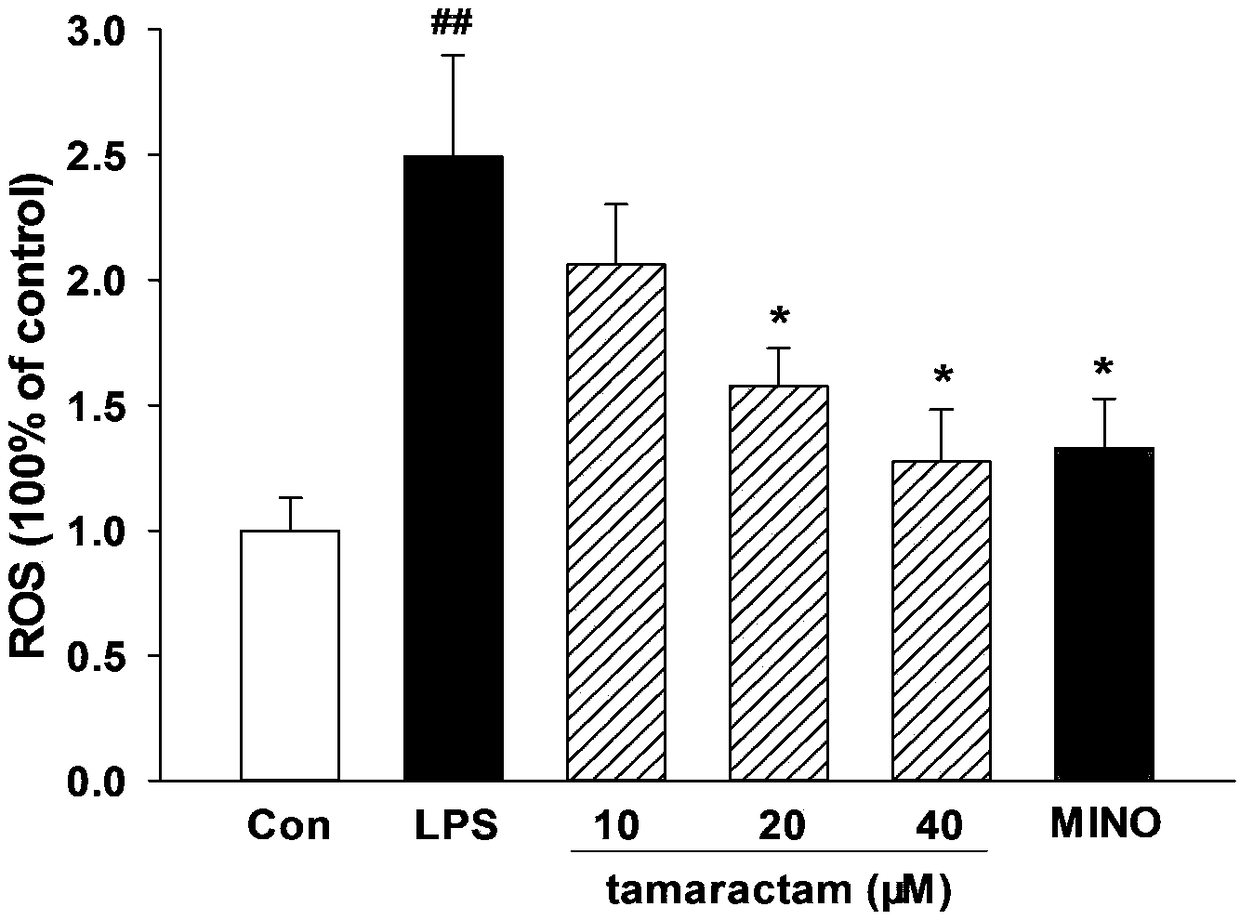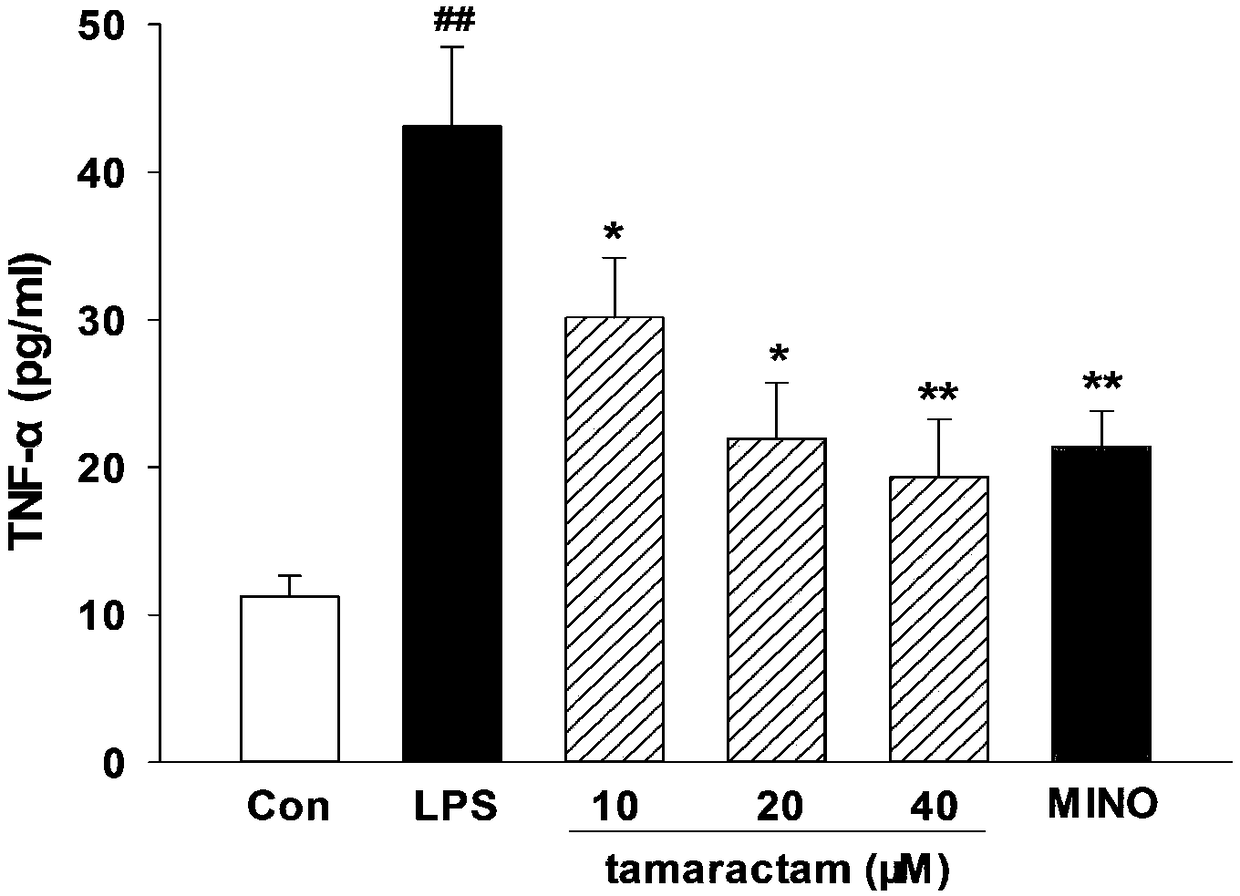Application of scopolin to preparation of medicine for inhibiting neuroinflammation
A technology of scopolamine and neuroinflammation, which is applied in the application field of scopolamine in the preparation of drugs for inhibiting neuroinflammation, can solve problems such as no scopolamine, and achieve significant neuroinflammation activity, high clinical application value and development prospect. , the effect of inhibiting neuroinflammatory activity
- Summary
- Abstract
- Description
- Claims
- Application Information
AI Technical Summary
Problems solved by technology
Method used
Image
Examples
Embodiment 1
[0031] The inhibitory effect of scopolamine on the release of nitric oxide (NO) from microglia induced by LPS was investigated by Griess colorimetry;
[0032] Cell line: mouse microglial cell line BV-2;
[0033] Drugs: LPS; Scopolamine; Minocycline (MINO).
[0034] method:
[0035] (1) Culture of mouse microglial cell line BV-2:
[0036] The cell culture solution was prepared based on DMEM medium, containing 10% FBS, 100 U penicillin and 100 U streptomycin, and 50 μM 2-mercaptoethanol (all final concentrations). at 5% CO 2 , under the condition of 37 ℃, the BV-2 microglial cells were divided into about 4×10 5 The cell density of cells / ml was cultured in a cell culture incubator, and the growth of the cells was observed regularly. When the area of the cell adherence accounted for about 50-60% of the bottom area of the culture flask, the cells were digested with trypsin and passaged, and then continued to culture. Take 3-7 generations of cells for experiments.
[0037]...
Embodiment 2
[0044] DCFH oxidation was used to investigate the effect of scopolamine on the release of reactive oxygen species (ROS) from microglia induced by LPS;
[0045] Cell line: mouse microglial cell line BV-2;
[0046] Drugs: LPS; Scopolamine; MINO.
[0047] Experimental principle: DCFH-DA (2′,7′-dichlorodihydrofluororescein diacetate) can enter the cell and undergo a deacetylation reaction to generate DCFH. DCFH is a non-fluorescent substance, which can be oxidized by intracellular ROS to generate fluorescent substance DCF, and the amount of ROS release can be reflected by detecting the fluorescence intensity. The specific operation steps are as follows: DCFH-DA was dissolved in pure methanol to prepare a mother solution with a concentration of 10 mM, and the mother solution was diluted 500 times with Hank's balanced salt solution (HBSS) to a final concentration of 20 μM before use. Take the BV-2 cells after drug treatment, suck the supernatant, incubate with the 20 μM DCFH-DA so...
Embodiment 3
[0051] The effects of scopolamine on the release of tumor necrosis factor-α (TNF-α) and interleukin-1β (IL-1β) from microglial cells induced by LPS were investigated by ELISA;
[0052] Cell line: mouse microglial cell line BV-2;
[0053] Drugs: LPS; Scopolamine; MINO.
[0054] Detection method: Take BV-2 cells in the logarithmic growth phase, inoculate the cells in a 6-well plate with fresh serum-free DMEM medium, and the cell density is 3×10 5 cells / ml, inoculum volume 600μl / well, placed in an incubator at 37°C, 5% CO 2 cultivated under conditions. After the cells adhered to the wall for 3 hours, the culture solution was carefully sucked out, and according to the experimental group, the cells were replaced with different drugs prepared in serum-free DMEM culture solution to incubate the cells. At the same time, a blank control group was set up, and each group was set with 3 replicate wells, and the drug addition to the cells continued. After culturing for 2-4 hours, collec...
PUM
 Login to View More
Login to View More Abstract
Description
Claims
Application Information
 Login to View More
Login to View More - R&D
- Intellectual Property
- Life Sciences
- Materials
- Tech Scout
- Unparalleled Data Quality
- Higher Quality Content
- 60% Fewer Hallucinations
Browse by: Latest US Patents, China's latest patents, Technical Efficacy Thesaurus, Application Domain, Technology Topic, Popular Technical Reports.
© 2025 PatSnap. All rights reserved.Legal|Privacy policy|Modern Slavery Act Transparency Statement|Sitemap|About US| Contact US: help@patsnap.com



